Vodafone's Strategic Management & Analysis in the UK Telecom Sector
VerifiedAdded on 2023/02/01
|16
|5052
|50
Report
AI Summary
This report provides a comprehensive analysis of Vodafone's business strategy within the UK telecom sector. It begins by examining the impact of macro-environmental factors using PESTEL analysis, evaluating political, economic, social, technological, environmental, and legal influences on Vodafone's operations. The report then assesses Vodafone's internal capabilities through the VRIO model, focusing on valuable, rare, inimitable, and organization-specific resources to determine its competitive advantages. Porter's Five Forces model is applied to evaluate the competitive landscape, and strategic planning is interpreted using various theories and concepts. The analysis concludes with strategic recommendations for Vodafone, emphasizing cost leadership and differentiation through 5G services to enhance market position and generate sustained revenue. This document is available on Desklib, a platform offering a range of study tools for students.
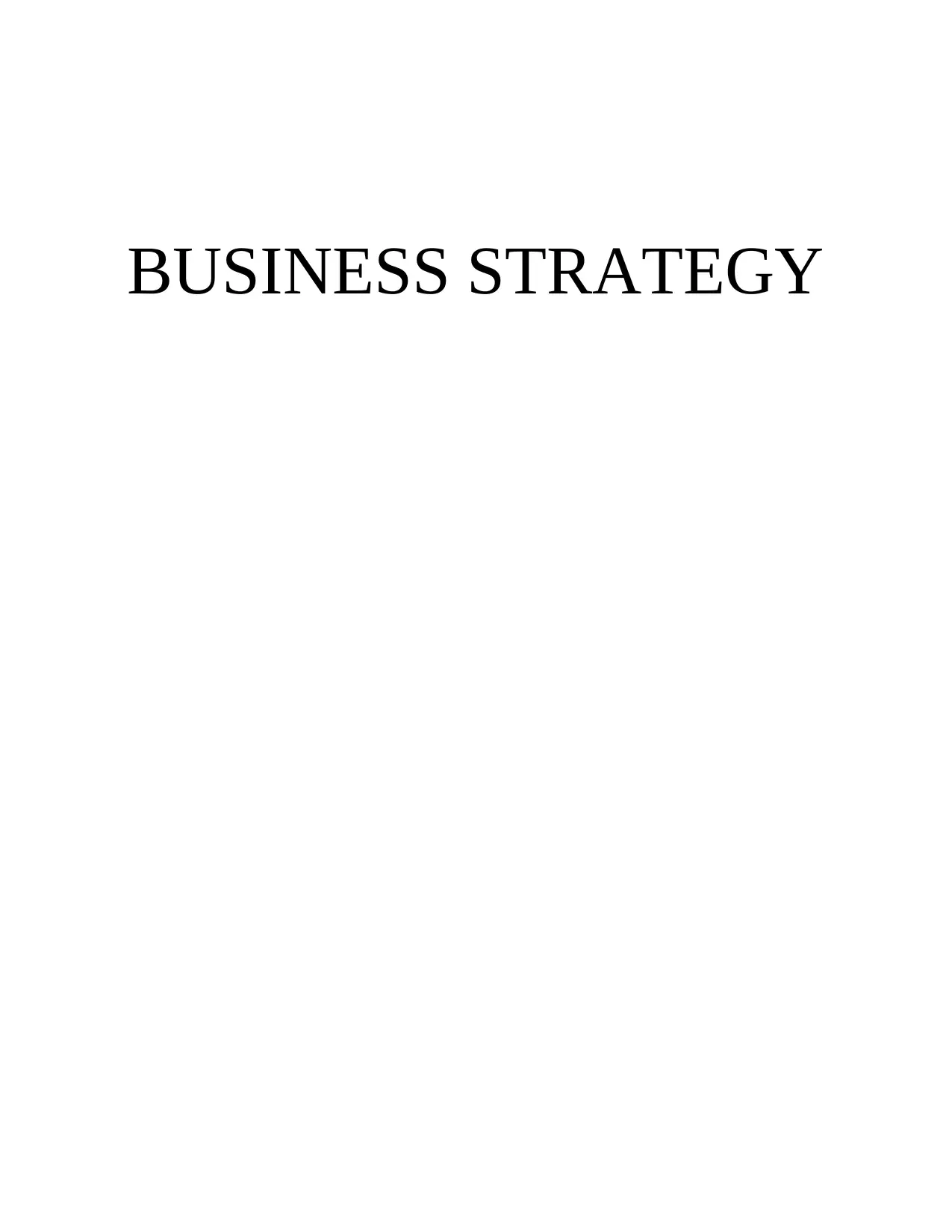
BUSINESS STRATEGY
Paraphrase This Document
Need a fresh take? Get an instant paraphrase of this document with our AI Paraphraser
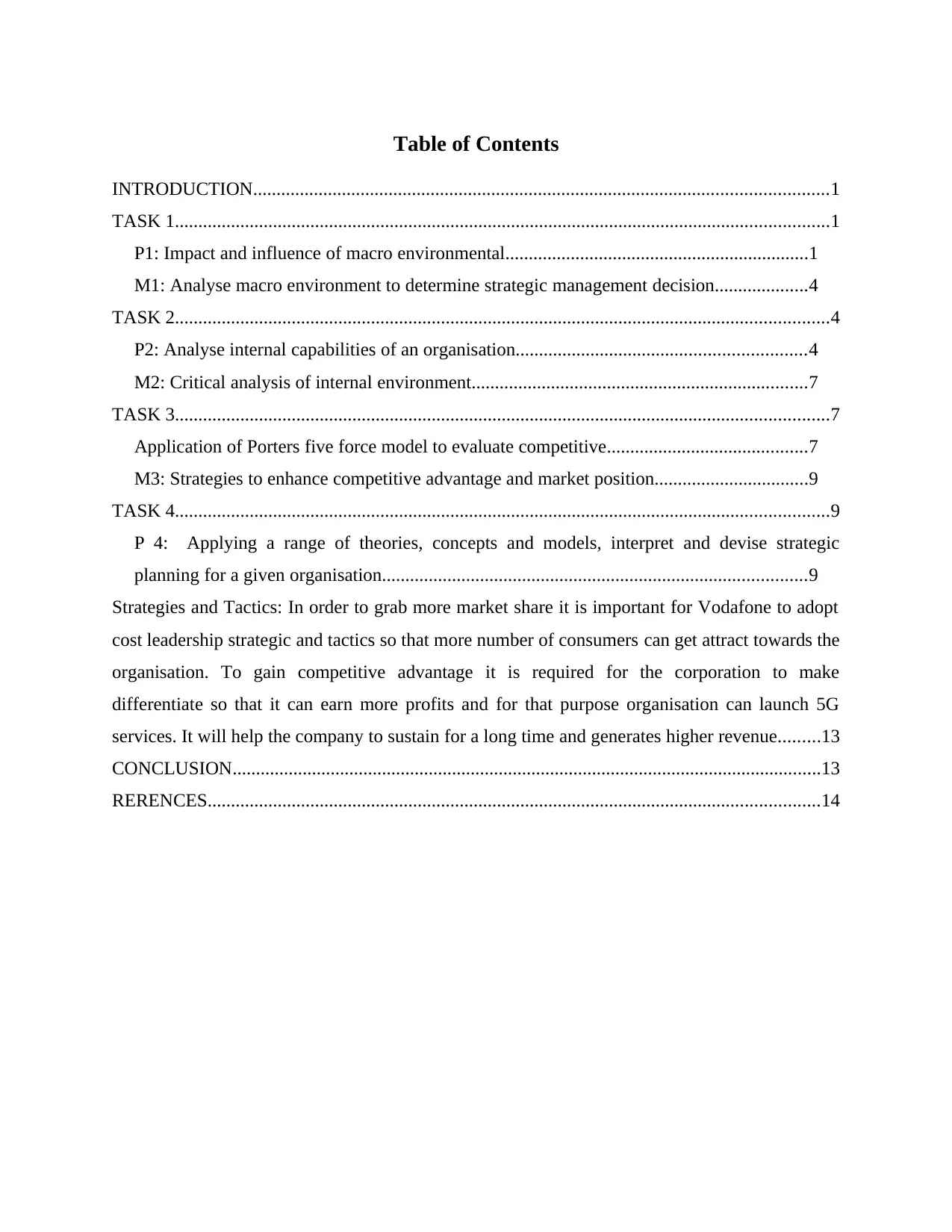
Table of Contents
INTRODUCTION...........................................................................................................................1
TASK 1............................................................................................................................................1
P1: Impact and influence of macro environmental.................................................................1
M1: Analyse macro environment to determine strategic management decision....................4
TASK 2............................................................................................................................................4
P2: Analyse internal capabilities of an organisation..............................................................4
M2: Critical analysis of internal environment........................................................................7
TASK 3............................................................................................................................................7
Application of Porters five force model to evaluate competitive...........................................7
M3: Strategies to enhance competitive advantage and market position.................................9
TASK 4............................................................................................................................................9
P 4: Applying a range of theories, concepts and models, interpret and devise strategic
planning for a given organisation...........................................................................................9
Strategies and Tactics: In order to grab more market share it is important for Vodafone to adopt
cost leadership strategic and tactics so that more number of consumers can get attract towards the
organisation. To gain competitive advantage it is required for the corporation to make
differentiate so that it can earn more profits and for that purpose organisation can launch 5G
services. It will help the company to sustain for a long time and generates higher revenue.........13
CONCLUSION..............................................................................................................................13
RERENCES...................................................................................................................................14
INTRODUCTION...........................................................................................................................1
TASK 1............................................................................................................................................1
P1: Impact and influence of macro environmental.................................................................1
M1: Analyse macro environment to determine strategic management decision....................4
TASK 2............................................................................................................................................4
P2: Analyse internal capabilities of an organisation..............................................................4
M2: Critical analysis of internal environment........................................................................7
TASK 3............................................................................................................................................7
Application of Porters five force model to evaluate competitive...........................................7
M3: Strategies to enhance competitive advantage and market position.................................9
TASK 4............................................................................................................................................9
P 4: Applying a range of theories, concepts and models, interpret and devise strategic
planning for a given organisation...........................................................................................9
Strategies and Tactics: In order to grab more market share it is important for Vodafone to adopt
cost leadership strategic and tactics so that more number of consumers can get attract towards the
organisation. To gain competitive advantage it is required for the corporation to make
differentiate so that it can earn more profits and for that purpose organisation can launch 5G
services. It will help the company to sustain for a long time and generates higher revenue.........13
CONCLUSION..............................................................................................................................13
RERENCES...................................................................................................................................14
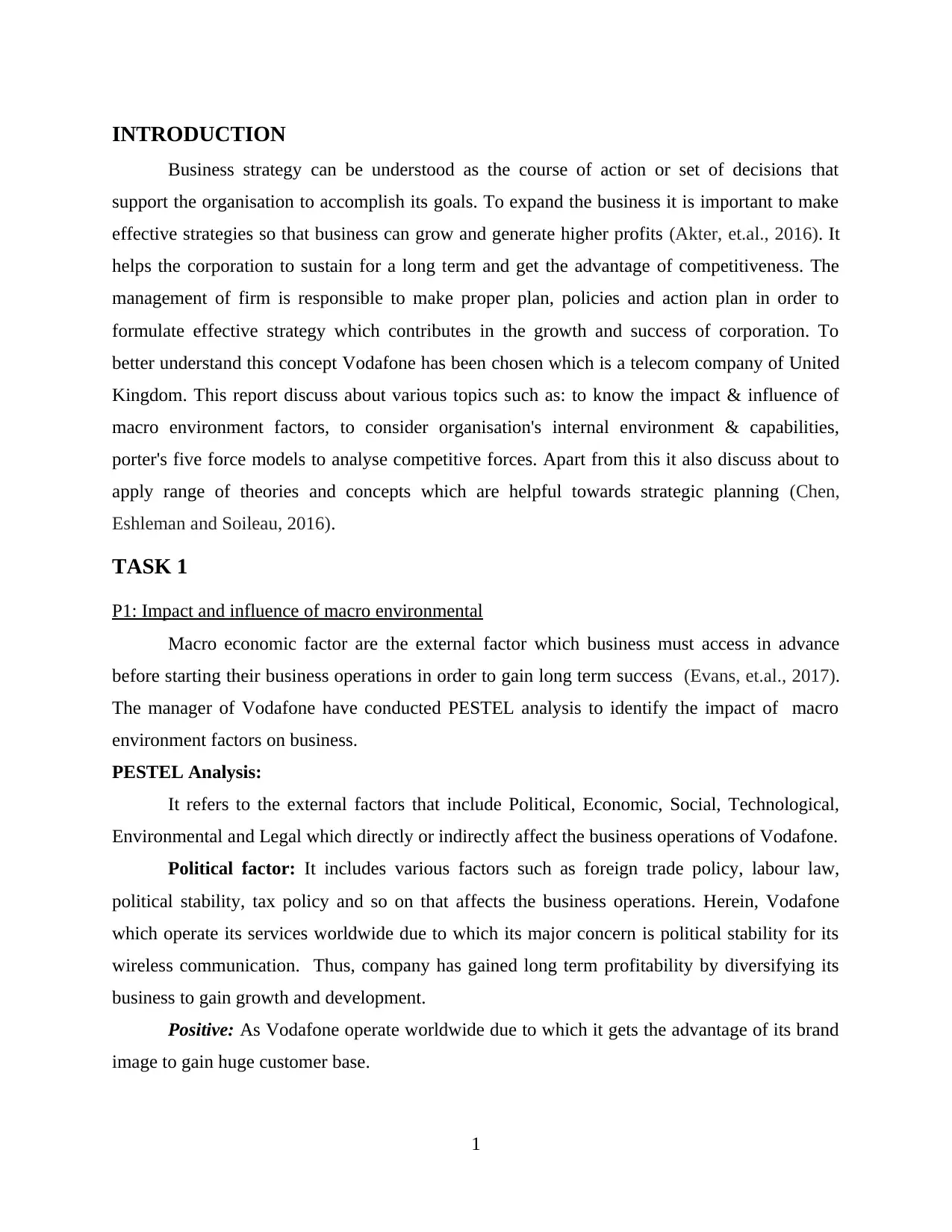
INTRODUCTION
Business strategy can be understood as the course of action or set of decisions that
support the organisation to accomplish its goals. To expand the business it is important to make
effective strategies so that business can grow and generate higher profits (Akter, et.al., 2016). It
helps the corporation to sustain for a long term and get the advantage of competitiveness. The
management of firm is responsible to make proper plan, policies and action plan in order to
formulate effective strategy which contributes in the growth and success of corporation. To
better understand this concept Vodafone has been chosen which is a telecom company of United
Kingdom. This report discuss about various topics such as: to know the impact & influence of
macro environment factors, to consider organisation's internal environment & capabilities,
porter's five force models to analyse competitive forces. Apart from this it also discuss about to
apply range of theories and concepts which are helpful towards strategic planning (Chen,
Eshleman and Soileau, 2016).
TASK 1
P1: Impact and influence of macro environmental
Macro economic factor are the external factor which business must access in advance
before starting their business operations in order to gain long term success (Evans, et.al., 2017).
The manager of Vodafone have conducted PESTEL analysis to identify the impact of macro
environment factors on business.
PESTEL Analysis:
It refers to the external factors that include Political, Economic, Social, Technological,
Environmental and Legal which directly or indirectly affect the business operations of Vodafone.
Political factor: It includes various factors such as foreign trade policy, labour law,
political stability, tax policy and so on that affects the business operations. Herein, Vodafone
which operate its services worldwide due to which its major concern is political stability for its
wireless communication. Thus, company has gained long term profitability by diversifying its
business to gain growth and development.
Positive: As Vodafone operate worldwide due to which it gets the advantage of its brand
image to gain huge customer base.
1
Business strategy can be understood as the course of action or set of decisions that
support the organisation to accomplish its goals. To expand the business it is important to make
effective strategies so that business can grow and generate higher profits (Akter, et.al., 2016). It
helps the corporation to sustain for a long term and get the advantage of competitiveness. The
management of firm is responsible to make proper plan, policies and action plan in order to
formulate effective strategy which contributes in the growth and success of corporation. To
better understand this concept Vodafone has been chosen which is a telecom company of United
Kingdom. This report discuss about various topics such as: to know the impact & influence of
macro environment factors, to consider organisation's internal environment & capabilities,
porter's five force models to analyse competitive forces. Apart from this it also discuss about to
apply range of theories and concepts which are helpful towards strategic planning (Chen,
Eshleman and Soileau, 2016).
TASK 1
P1: Impact and influence of macro environmental
Macro economic factor are the external factor which business must access in advance
before starting their business operations in order to gain long term success (Evans, et.al., 2017).
The manager of Vodafone have conducted PESTEL analysis to identify the impact of macro
environment factors on business.
PESTEL Analysis:
It refers to the external factors that include Political, Economic, Social, Technological,
Environmental and Legal which directly or indirectly affect the business operations of Vodafone.
Political factor: It includes various factors such as foreign trade policy, labour law,
political stability, tax policy and so on that affects the business operations. Herein, Vodafone
which operate its services worldwide due to which its major concern is political stability for its
wireless communication. Thus, company has gained long term profitability by diversifying its
business to gain growth and development.
Positive: As Vodafone operate worldwide due to which it gets the advantage of its brand
image to gain huge customer base.
1
⊘ This is a preview!⊘
Do you want full access?
Subscribe today to unlock all pages.

Trusted by 1+ million students worldwide
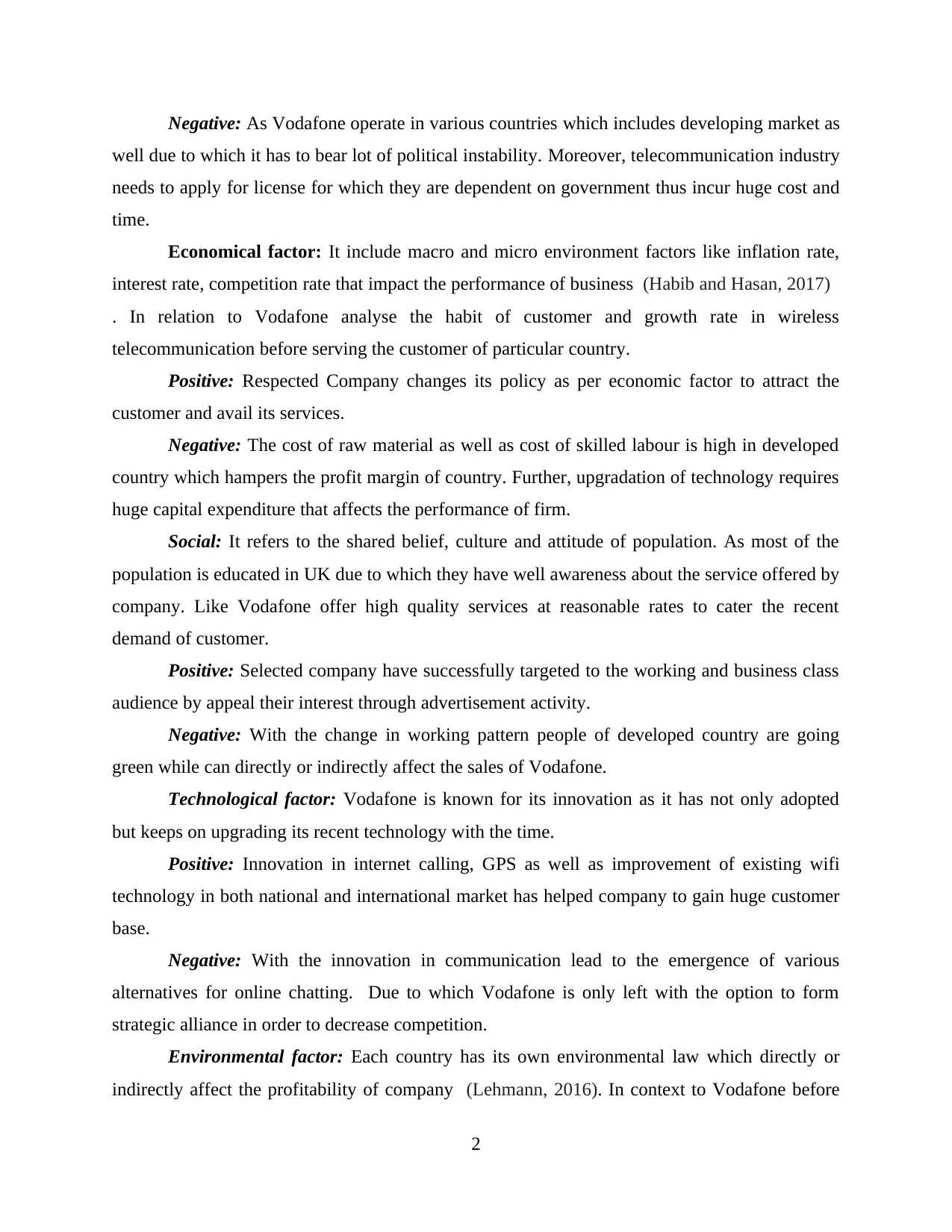
Negative: As Vodafone operate in various countries which includes developing market as
well due to which it has to bear lot of political instability. Moreover, telecommunication industry
needs to apply for license for which they are dependent on government thus incur huge cost and
time.
Economical factor: It include macro and micro environment factors like inflation rate,
interest rate, competition rate that impact the performance of business (Habib and Hasan, 2017)
. In relation to Vodafone analyse the habit of customer and growth rate in wireless
telecommunication before serving the customer of particular country.
Positive: Respected Company changes its policy as per economic factor to attract the
customer and avail its services.
Negative: The cost of raw material as well as cost of skilled labour is high in developed
country which hampers the profit margin of country. Further, upgradation of technology requires
huge capital expenditure that affects the performance of firm.
Social: It refers to the shared belief, culture and attitude of population. As most of the
population is educated in UK due to which they have well awareness about the service offered by
company. Like Vodafone offer high quality services at reasonable rates to cater the recent
demand of customer.
Positive: Selected company have successfully targeted to the working and business class
audience by appeal their interest through advertisement activity.
Negative: With the change in working pattern people of developed country are going
green while can directly or indirectly affect the sales of Vodafone.
Technological factor: Vodafone is known for its innovation as it has not only adopted
but keeps on upgrading its recent technology with the time.
Positive: Innovation in internet calling, GPS as well as improvement of existing wifi
technology in both national and international market has helped company to gain huge customer
base.
Negative: With the innovation in communication lead to the emergence of various
alternatives for online chatting. Due to which Vodafone is only left with the option to form
strategic alliance in order to decrease competition.
Environmental factor: Each country has its own environmental law which directly or
indirectly affect the profitability of company (Lehmann, 2016). In context to Vodafone before
2
well due to which it has to bear lot of political instability. Moreover, telecommunication industry
needs to apply for license for which they are dependent on government thus incur huge cost and
time.
Economical factor: It include macro and micro environment factors like inflation rate,
interest rate, competition rate that impact the performance of business (Habib and Hasan, 2017)
. In relation to Vodafone analyse the habit of customer and growth rate in wireless
telecommunication before serving the customer of particular country.
Positive: Respected Company changes its policy as per economic factor to attract the
customer and avail its services.
Negative: The cost of raw material as well as cost of skilled labour is high in developed
country which hampers the profit margin of country. Further, upgradation of technology requires
huge capital expenditure that affects the performance of firm.
Social: It refers to the shared belief, culture and attitude of population. As most of the
population is educated in UK due to which they have well awareness about the service offered by
company. Like Vodafone offer high quality services at reasonable rates to cater the recent
demand of customer.
Positive: Selected company have successfully targeted to the working and business class
audience by appeal their interest through advertisement activity.
Negative: With the change in working pattern people of developed country are going
green while can directly or indirectly affect the sales of Vodafone.
Technological factor: Vodafone is known for its innovation as it has not only adopted
but keeps on upgrading its recent technology with the time.
Positive: Innovation in internet calling, GPS as well as improvement of existing wifi
technology in both national and international market has helped company to gain huge customer
base.
Negative: With the innovation in communication lead to the emergence of various
alternatives for online chatting. Due to which Vodafone is only left with the option to form
strategic alliance in order to decrease competition.
Environmental factor: Each country has its own environmental law which directly or
indirectly affect the profitability of company (Lehmann, 2016). In context to Vodafone before
2
Paraphrase This Document
Need a fresh take? Get an instant paraphrase of this document with our AI Paraphraser
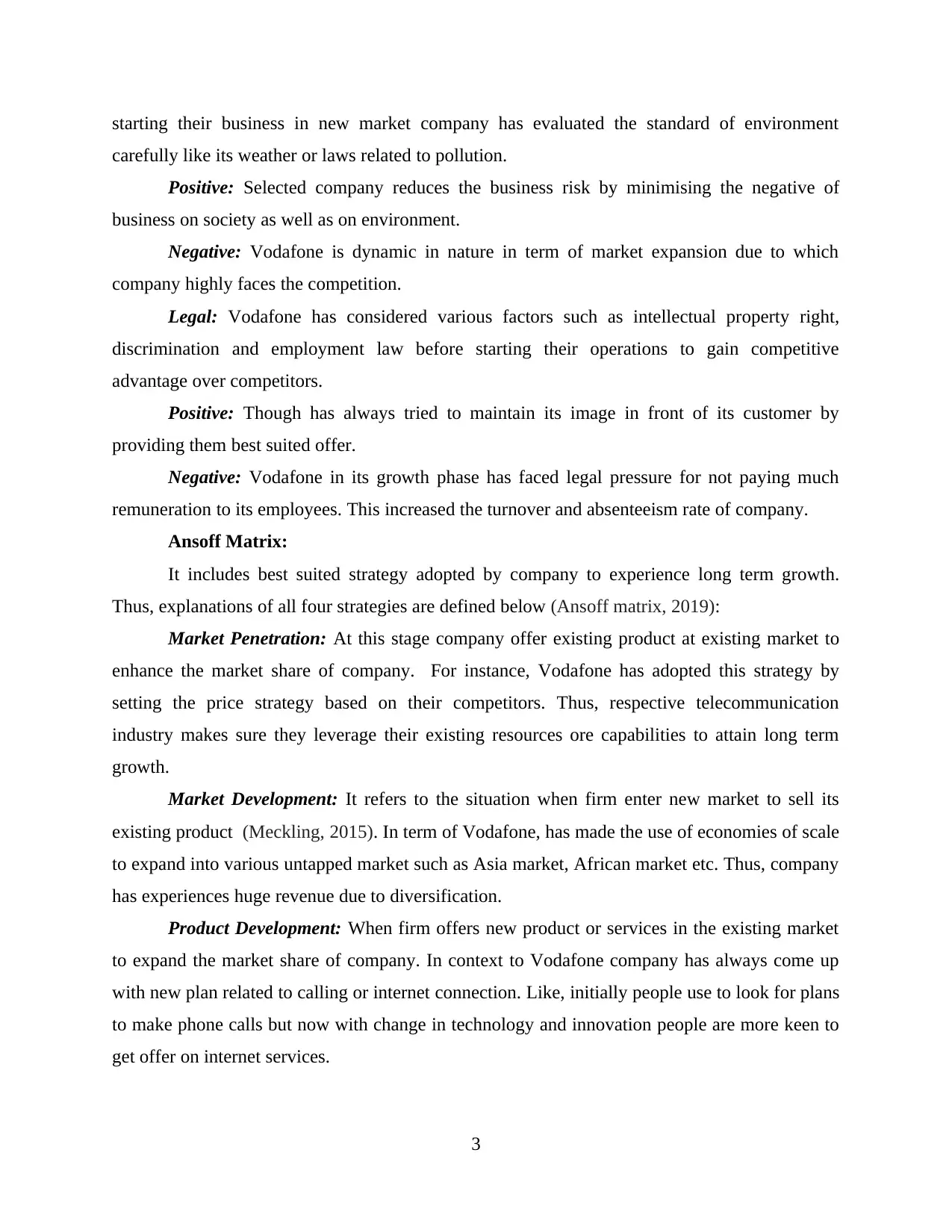
starting their business in new market company has evaluated the standard of environment
carefully like its weather or laws related to pollution.
Positive: Selected company reduces the business risk by minimising the negative of
business on society as well as on environment.
Negative: Vodafone is dynamic in nature in term of market expansion due to which
company highly faces the competition.
Legal: Vodafone has considered various factors such as intellectual property right,
discrimination and employment law before starting their operations to gain competitive
advantage over competitors.
Positive: Though has always tried to maintain its image in front of its customer by
providing them best suited offer.
Negative: Vodafone in its growth phase has faced legal pressure for not paying much
remuneration to its employees. This increased the turnover and absenteeism rate of company.
Ansoff Matrix:
It includes best suited strategy adopted by company to experience long term growth.
Thus, explanations of all four strategies are defined below (Ansoff matrix, 2019):
Market Penetration: At this stage company offer existing product at existing market to
enhance the market share of company. For instance, Vodafone has adopted this strategy by
setting the price strategy based on their competitors. Thus, respective telecommunication
industry makes sure they leverage their existing resources ore capabilities to attain long term
growth.
Market Development: It refers to the situation when firm enter new market to sell its
existing product (Meckling, 2015). In term of Vodafone, has made the use of economies of scale
to expand into various untapped market such as Asia market, African market etc. Thus, company
has experiences huge revenue due to diversification.
Product Development: When firm offers new product or services in the existing market
to expand the market share of company. In context to Vodafone company has always come up
with new plan related to calling or internet connection. Like, initially people use to look for plans
to make phone calls but now with change in technology and innovation people are more keen to
get offer on internet services.
3
carefully like its weather or laws related to pollution.
Positive: Selected company reduces the business risk by minimising the negative of
business on society as well as on environment.
Negative: Vodafone is dynamic in nature in term of market expansion due to which
company highly faces the competition.
Legal: Vodafone has considered various factors such as intellectual property right,
discrimination and employment law before starting their operations to gain competitive
advantage over competitors.
Positive: Though has always tried to maintain its image in front of its customer by
providing them best suited offer.
Negative: Vodafone in its growth phase has faced legal pressure for not paying much
remuneration to its employees. This increased the turnover and absenteeism rate of company.
Ansoff Matrix:
It includes best suited strategy adopted by company to experience long term growth.
Thus, explanations of all four strategies are defined below (Ansoff matrix, 2019):
Market Penetration: At this stage company offer existing product at existing market to
enhance the market share of company. For instance, Vodafone has adopted this strategy by
setting the price strategy based on their competitors. Thus, respective telecommunication
industry makes sure they leverage their existing resources ore capabilities to attain long term
growth.
Market Development: It refers to the situation when firm enter new market to sell its
existing product (Meckling, 2015). In term of Vodafone, has made the use of economies of scale
to expand into various untapped market such as Asia market, African market etc. Thus, company
has experiences huge revenue due to diversification.
Product Development: When firm offers new product or services in the existing market
to expand the market share of company. In context to Vodafone company has always come up
with new plan related to calling or internet connection. Like, initially people use to look for plans
to make phone calls but now with change in technology and innovation people are more keen to
get offer on internet services.
3
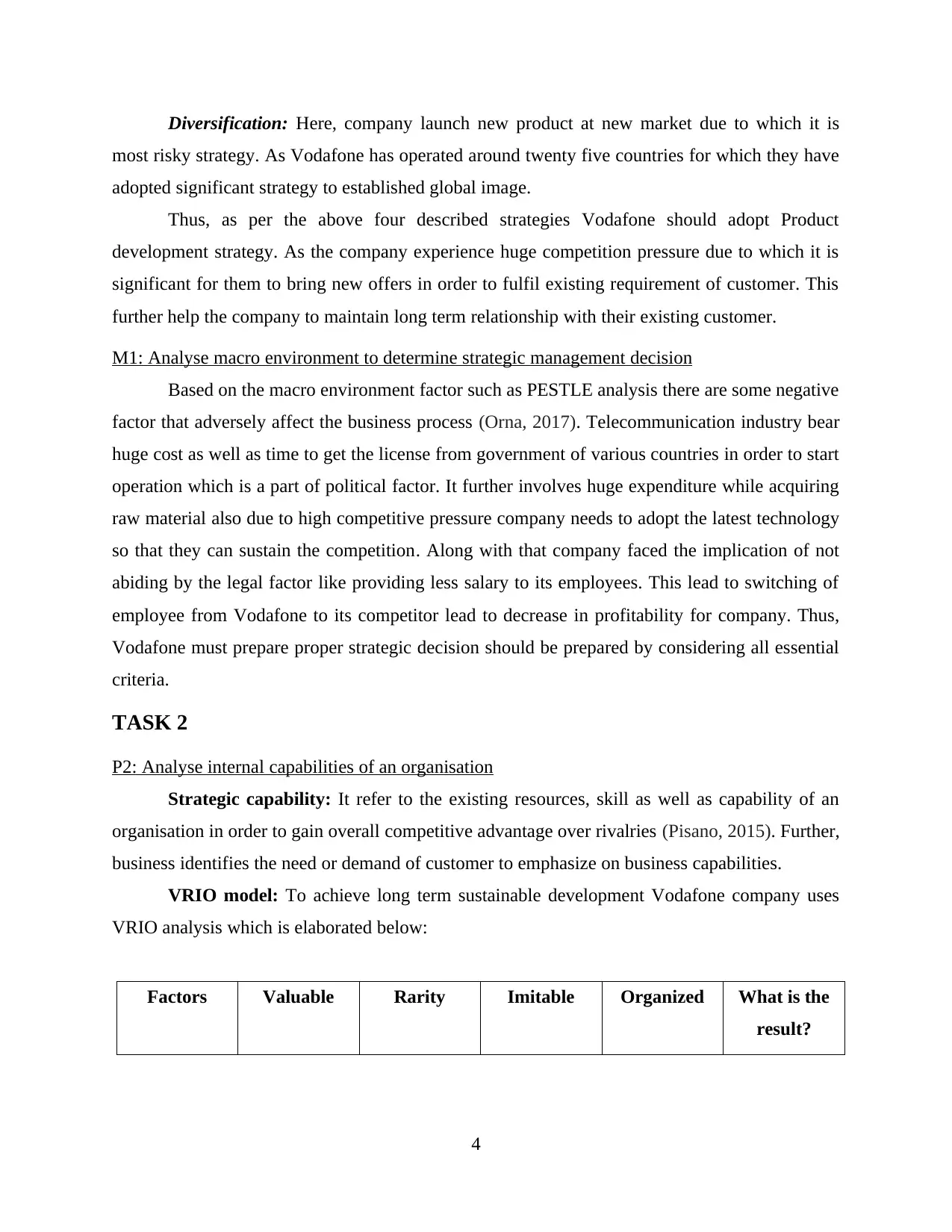
Diversification: Here, company launch new product at new market due to which it is
most risky strategy. As Vodafone has operated around twenty five countries for which they have
adopted significant strategy to established global image.
Thus, as per the above four described strategies Vodafone should adopt Product
development strategy. As the company experience huge competition pressure due to which it is
significant for them to bring new offers in order to fulfil existing requirement of customer. This
further help the company to maintain long term relationship with their existing customer.
M1: Analyse macro environment to determine strategic management decision
Based on the macro environment factor such as PESTLE analysis there are some negative
factor that adversely affect the business process (Orna, 2017). Telecommunication industry bear
huge cost as well as time to get the license from government of various countries in order to start
operation which is a part of political factor. It further involves huge expenditure while acquiring
raw material also due to high competitive pressure company needs to adopt the latest technology
so that they can sustain the competition. Along with that company faced the implication of not
abiding by the legal factor like providing less salary to its employees. This lead to switching of
employee from Vodafone to its competitor lead to decrease in profitability for company. Thus,
Vodafone must prepare proper strategic decision should be prepared by considering all essential
criteria.
TASK 2
P2: Analyse internal capabilities of an organisation
Strategic capability: It refer to the existing resources, skill as well as capability of an
organisation in order to gain overall competitive advantage over rivalries (Pisano, 2015). Further,
business identifies the need or demand of customer to emphasize on business capabilities.
VRIO model: To achieve long term sustainable development Vodafone company uses
VRIO analysis which is elaborated below:
Factors Valuable Rarity Imitable Organized What is the
result?
4
most risky strategy. As Vodafone has operated around twenty five countries for which they have
adopted significant strategy to established global image.
Thus, as per the above four described strategies Vodafone should adopt Product
development strategy. As the company experience huge competition pressure due to which it is
significant for them to bring new offers in order to fulfil existing requirement of customer. This
further help the company to maintain long term relationship with their existing customer.
M1: Analyse macro environment to determine strategic management decision
Based on the macro environment factor such as PESTLE analysis there are some negative
factor that adversely affect the business process (Orna, 2017). Telecommunication industry bear
huge cost as well as time to get the license from government of various countries in order to start
operation which is a part of political factor. It further involves huge expenditure while acquiring
raw material also due to high competitive pressure company needs to adopt the latest technology
so that they can sustain the competition. Along with that company faced the implication of not
abiding by the legal factor like providing less salary to its employees. This lead to switching of
employee from Vodafone to its competitor lead to decrease in profitability for company. Thus,
Vodafone must prepare proper strategic decision should be prepared by considering all essential
criteria.
TASK 2
P2: Analyse internal capabilities of an organisation
Strategic capability: It refer to the existing resources, skill as well as capability of an
organisation in order to gain overall competitive advantage over rivalries (Pisano, 2015). Further,
business identifies the need or demand of customer to emphasize on business capabilities.
VRIO model: To achieve long term sustainable development Vodafone company uses
VRIO analysis which is elaborated below:
Factors Valuable Rarity Imitable Organized What is the
result?
4
⊘ This is a preview!⊘
Do you want full access?
Subscribe today to unlock all pages.

Trusted by 1+ million students worldwide
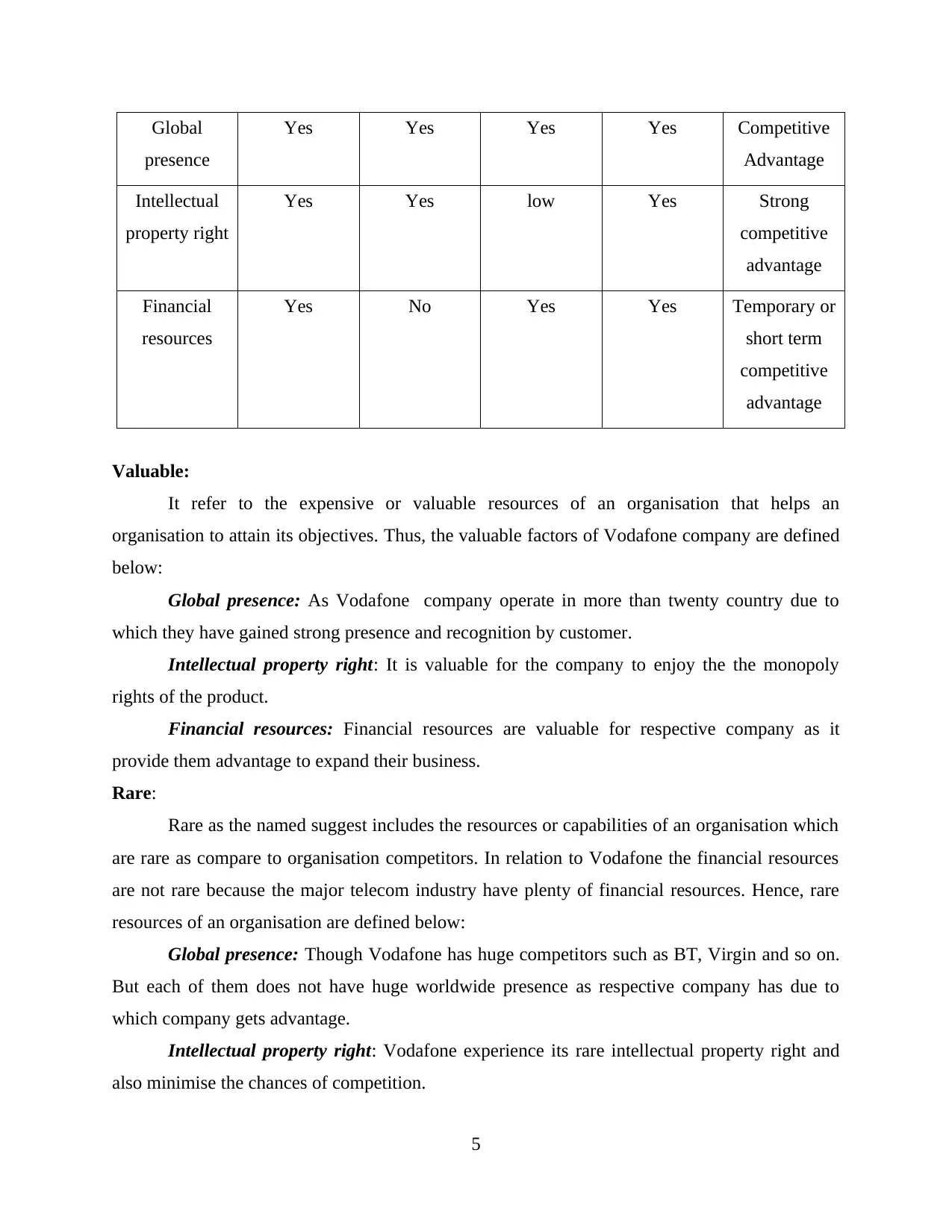
Global
presence
Yes Yes Yes Yes Competitive
Advantage
Intellectual
property right
Yes Yes low Yes Strong
competitive
advantage
Financial
resources
Yes No Yes Yes Temporary or
short term
competitive
advantage
Valuable:
It refer to the expensive or valuable resources of an organisation that helps an
organisation to attain its objectives. Thus, the valuable factors of Vodafone company are defined
below:
Global presence: As Vodafone company operate in more than twenty country due to
which they have gained strong presence and recognition by customer.
Intellectual property right: It is valuable for the company to enjoy the the monopoly
rights of the product.
Financial resources: Financial resources are valuable for respective company as it
provide them advantage to expand their business.
Rare:
Rare as the named suggest includes the resources or capabilities of an organisation which
are rare as compare to organisation competitors. In relation to Vodafone the financial resources
are not rare because the major telecom industry have plenty of financial resources. Hence, rare
resources of an organisation are defined below:
Global presence: Though Vodafone has huge competitors such as BT, Virgin and so on.
But each of them does not have huge worldwide presence as respective company has due to
which company gets advantage.
Intellectual property right: Vodafone experience its rare intellectual property right and
also minimise the chances of competition.
5
presence
Yes Yes Yes Yes Competitive
Advantage
Intellectual
property right
Yes Yes low Yes Strong
competitive
advantage
Financial
resources
Yes No Yes Yes Temporary or
short term
competitive
advantage
Valuable:
It refer to the expensive or valuable resources of an organisation that helps an
organisation to attain its objectives. Thus, the valuable factors of Vodafone company are defined
below:
Global presence: As Vodafone company operate in more than twenty country due to
which they have gained strong presence and recognition by customer.
Intellectual property right: It is valuable for the company to enjoy the the monopoly
rights of the product.
Financial resources: Financial resources are valuable for respective company as it
provide them advantage to expand their business.
Rare:
Rare as the named suggest includes the resources or capabilities of an organisation which
are rare as compare to organisation competitors. In relation to Vodafone the financial resources
are not rare because the major telecom industry have plenty of financial resources. Hence, rare
resources of an organisation are defined below:
Global presence: Though Vodafone has huge competitors such as BT, Virgin and so on.
But each of them does not have huge worldwide presence as respective company has due to
which company gets advantage.
Intellectual property right: Vodafone experience its rare intellectual property right and
also minimise the chances of competition.
5
Paraphrase This Document
Need a fresh take? Get an instant paraphrase of this document with our AI Paraphraser
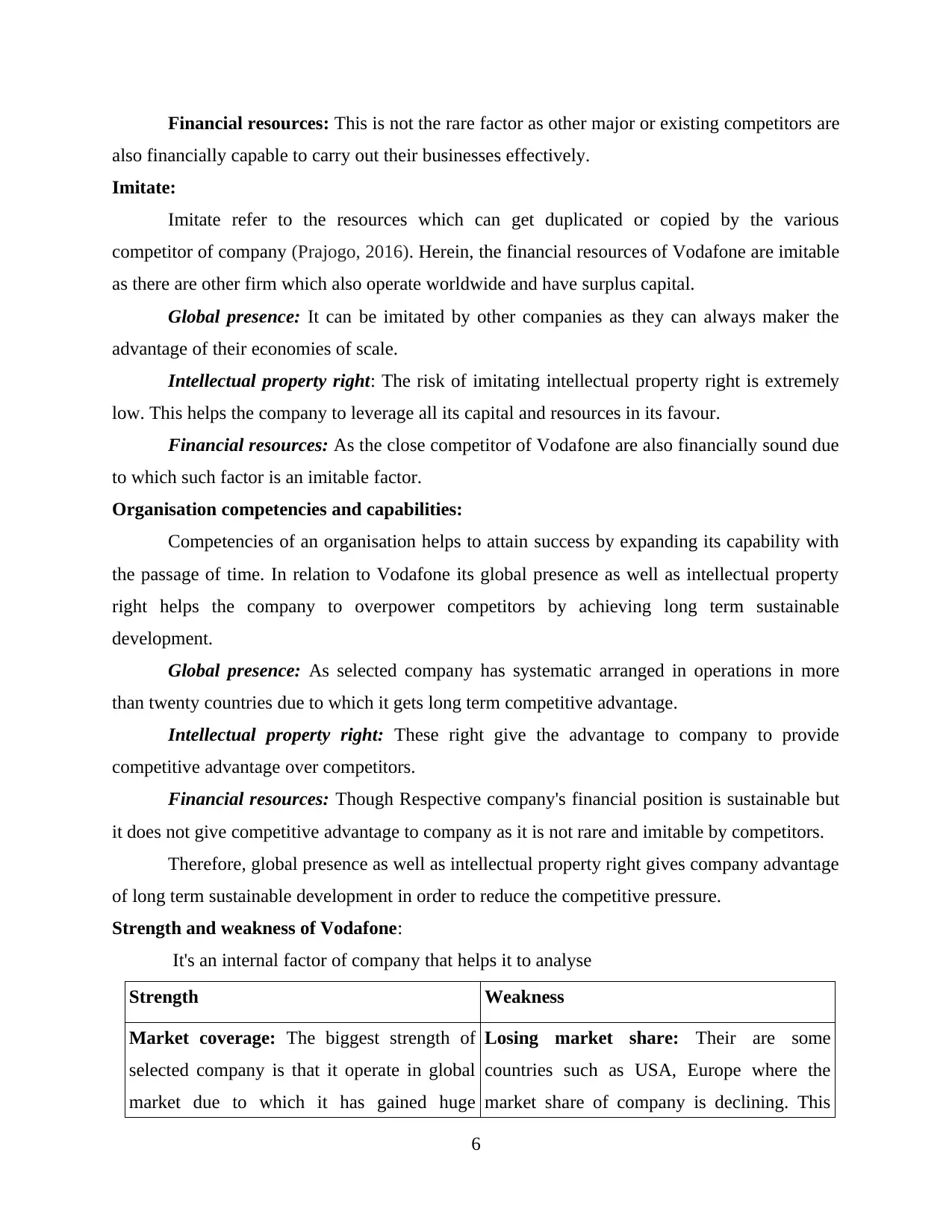
Financial resources: This is not the rare factor as other major or existing competitors are
also financially capable to carry out their businesses effectively.
Imitate:
Imitate refer to the resources which can get duplicated or copied by the various
competitor of company (Prajogo, 2016). Herein, the financial resources of Vodafone are imitable
as there are other firm which also operate worldwide and have surplus capital.
Global presence: It can be imitated by other companies as they can always maker the
advantage of their economies of scale.
Intellectual property right: The risk of imitating intellectual property right is extremely
low. This helps the company to leverage all its capital and resources in its favour.
Financial resources: As the close competitor of Vodafone are also financially sound due
to which such factor is an imitable factor.
Organisation competencies and capabilities:
Competencies of an organisation helps to attain success by expanding its capability with
the passage of time. In relation to Vodafone its global presence as well as intellectual property
right helps the company to overpower competitors by achieving long term sustainable
development.
Global presence: As selected company has systematic arranged in operations in more
than twenty countries due to which it gets long term competitive advantage.
Intellectual property right: These right give the advantage to company to provide
competitive advantage over competitors.
Financial resources: Though Respective company's financial position is sustainable but
it does not give competitive advantage to company as it is not rare and imitable by competitors.
Therefore, global presence as well as intellectual property right gives company advantage
of long term sustainable development in order to reduce the competitive pressure.
Strength and weakness of Vodafone:
It's an internal factor of company that helps it to analyse
Strength Weakness
Market coverage: The biggest strength of
selected company is that it operate in global
market due to which it has gained huge
Losing market share: Their are some
countries such as USA, Europe where the
market share of company is declining. This
6
also financially capable to carry out their businesses effectively.
Imitate:
Imitate refer to the resources which can get duplicated or copied by the various
competitor of company (Prajogo, 2016). Herein, the financial resources of Vodafone are imitable
as there are other firm which also operate worldwide and have surplus capital.
Global presence: It can be imitated by other companies as they can always maker the
advantage of their economies of scale.
Intellectual property right: The risk of imitating intellectual property right is extremely
low. This helps the company to leverage all its capital and resources in its favour.
Financial resources: As the close competitor of Vodafone are also financially sound due
to which such factor is an imitable factor.
Organisation competencies and capabilities:
Competencies of an organisation helps to attain success by expanding its capability with
the passage of time. In relation to Vodafone its global presence as well as intellectual property
right helps the company to overpower competitors by achieving long term sustainable
development.
Global presence: As selected company has systematic arranged in operations in more
than twenty countries due to which it gets long term competitive advantage.
Intellectual property right: These right give the advantage to company to provide
competitive advantage over competitors.
Financial resources: Though Respective company's financial position is sustainable but
it does not give competitive advantage to company as it is not rare and imitable by competitors.
Therefore, global presence as well as intellectual property right gives company advantage
of long term sustainable development in order to reduce the competitive pressure.
Strength and weakness of Vodafone:
It's an internal factor of company that helps it to analyse
Strength Weakness
Market coverage: The biggest strength of
selected company is that it operate in global
market due to which it has gained huge
Losing market share: Their are some
countries such as USA, Europe where the
market share of company is declining. This
6
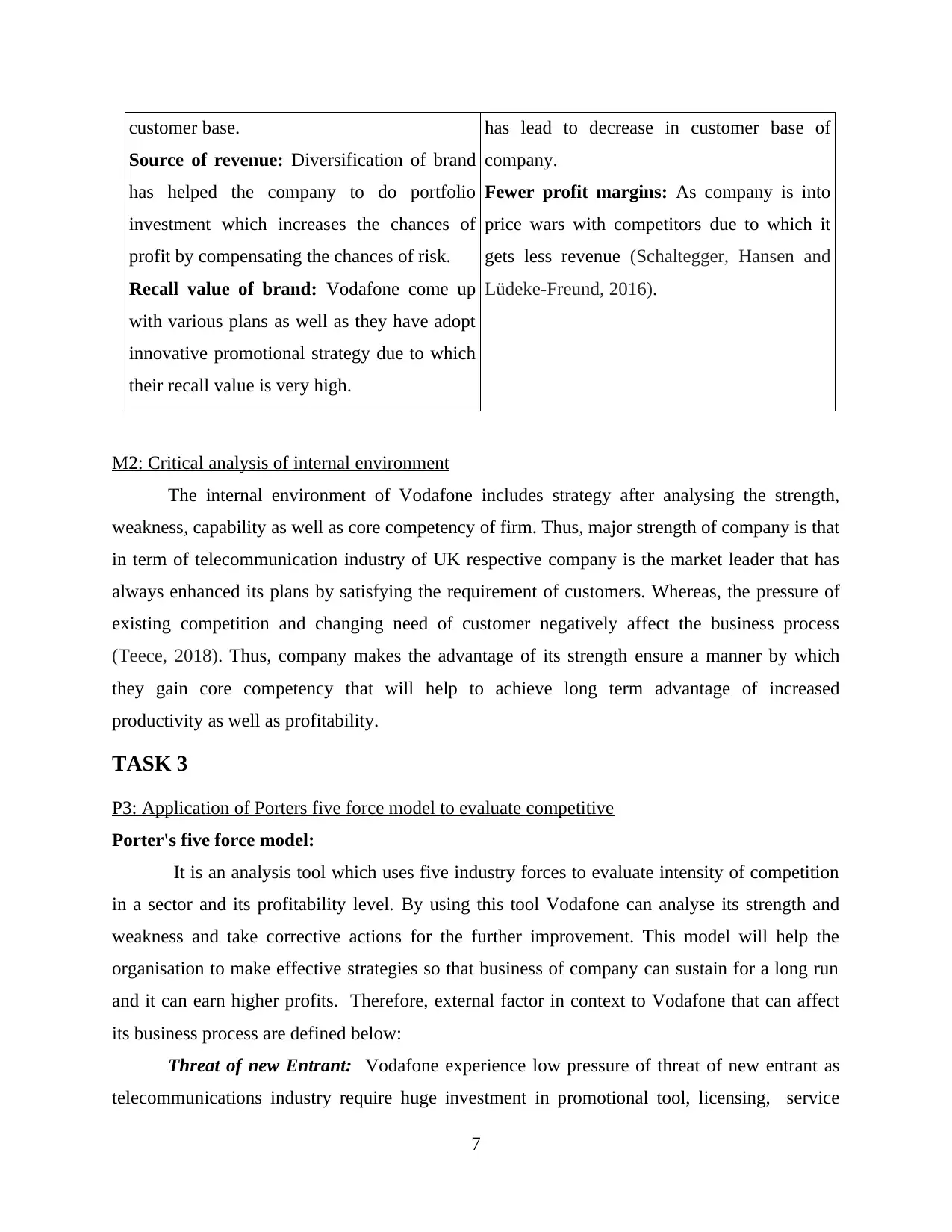
customer base.
Source of revenue: Diversification of brand
has helped the company to do portfolio
investment which increases the chances of
profit by compensating the chances of risk.
Recall value of brand: Vodafone come up
with various plans as well as they have adopt
innovative promotional strategy due to which
their recall value is very high.
has lead to decrease in customer base of
company.
Fewer profit margins: As company is into
price wars with competitors due to which it
gets less revenue (Schaltegger, Hansen and
Lüdeke-Freund, 2016).
M2: Critical analysis of internal environment
The internal environment of Vodafone includes strategy after analysing the strength,
weakness, capability as well as core competency of firm. Thus, major strength of company is that
in term of telecommunication industry of UK respective company is the market leader that has
always enhanced its plans by satisfying the requirement of customers. Whereas, the pressure of
existing competition and changing need of customer negatively affect the business process
(Teece, 2018). Thus, company makes the advantage of its strength ensure a manner by which
they gain core competency that will help to achieve long term advantage of increased
productivity as well as profitability.
TASK 3
P3: Application of Porters five force model to evaluate competitive
Porter's five force model:
It is an analysis tool which uses five industry forces to evaluate intensity of competition
in a sector and its profitability level. By using this tool Vodafone can analyse its strength and
weakness and take corrective actions for the further improvement. This model will help the
organisation to make effective strategies so that business of company can sustain for a long run
and it can earn higher profits. Therefore, external factor in context to Vodafone that can affect
its business process are defined below:
Threat of new Entrant: Vodafone experience low pressure of threat of new entrant as
telecommunications industry require huge investment in promotional tool, licensing, service
7
Source of revenue: Diversification of brand
has helped the company to do portfolio
investment which increases the chances of
profit by compensating the chances of risk.
Recall value of brand: Vodafone come up
with various plans as well as they have adopt
innovative promotional strategy due to which
their recall value is very high.
has lead to decrease in customer base of
company.
Fewer profit margins: As company is into
price wars with competitors due to which it
gets less revenue (Schaltegger, Hansen and
Lüdeke-Freund, 2016).
M2: Critical analysis of internal environment
The internal environment of Vodafone includes strategy after analysing the strength,
weakness, capability as well as core competency of firm. Thus, major strength of company is that
in term of telecommunication industry of UK respective company is the market leader that has
always enhanced its plans by satisfying the requirement of customers. Whereas, the pressure of
existing competition and changing need of customer negatively affect the business process
(Teece, 2018). Thus, company makes the advantage of its strength ensure a manner by which
they gain core competency that will help to achieve long term advantage of increased
productivity as well as profitability.
TASK 3
P3: Application of Porters five force model to evaluate competitive
Porter's five force model:
It is an analysis tool which uses five industry forces to evaluate intensity of competition
in a sector and its profitability level. By using this tool Vodafone can analyse its strength and
weakness and take corrective actions for the further improvement. This model will help the
organisation to make effective strategies so that business of company can sustain for a long run
and it can earn higher profits. Therefore, external factor in context to Vodafone that can affect
its business process are defined below:
Threat of new Entrant: Vodafone experience low pressure of threat of new entrant as
telecommunications industry require huge investment in promotional tool, licensing, service
7
⊘ This is a preview!⊘
Do you want full access?
Subscribe today to unlock all pages.

Trusted by 1+ million students worldwide
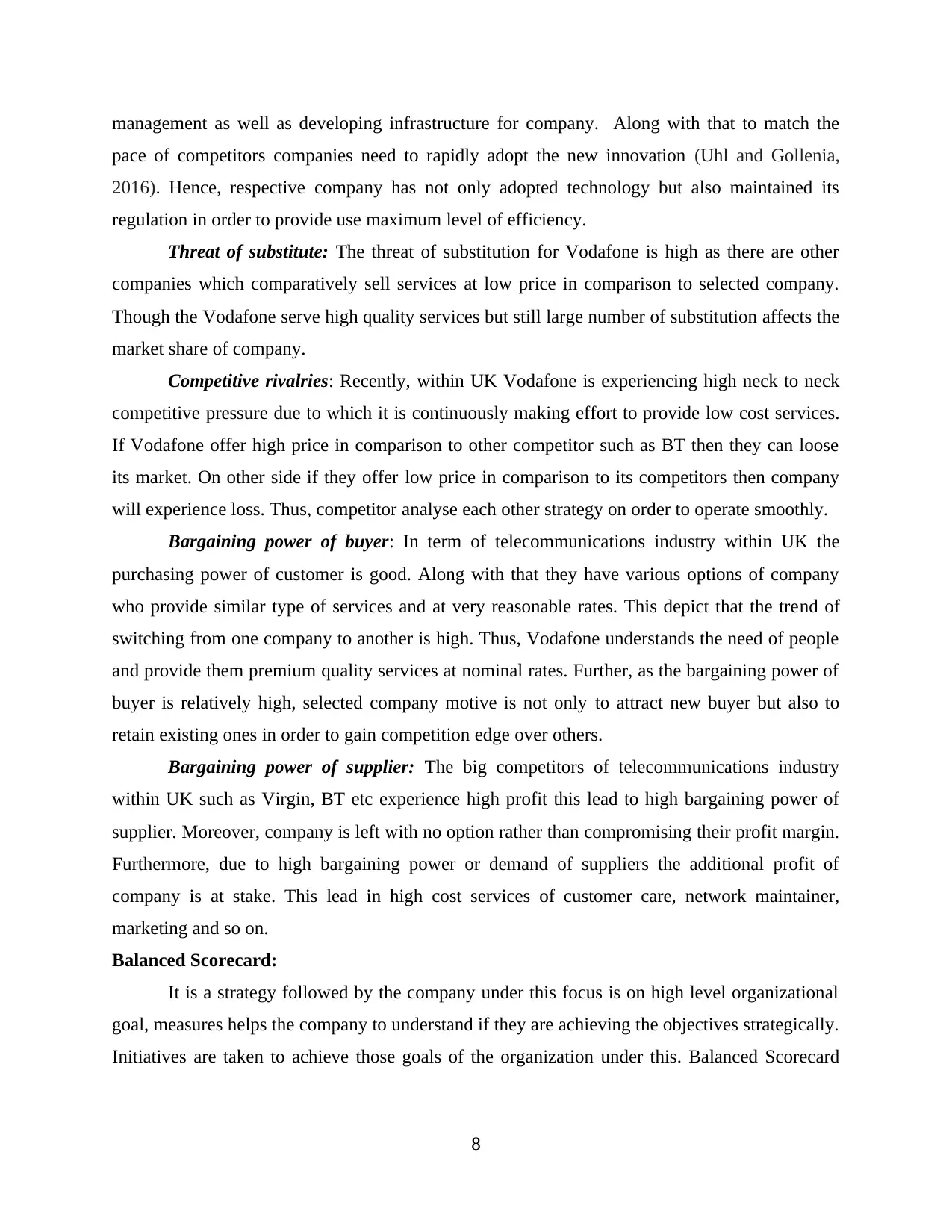
management as well as developing infrastructure for company. Along with that to match the
pace of competitors companies need to rapidly adopt the new innovation (Uhl and Gollenia,
2016). Hence, respective company has not only adopted technology but also maintained its
regulation in order to provide use maximum level of efficiency.
Threat of substitute: The threat of substitution for Vodafone is high as there are other
companies which comparatively sell services at low price in comparison to selected company.
Though the Vodafone serve high quality services but still large number of substitution affects the
market share of company.
Competitive rivalries: Recently, within UK Vodafone is experiencing high neck to neck
competitive pressure due to which it is continuously making effort to provide low cost services.
If Vodafone offer high price in comparison to other competitor such as BT then they can loose
its market. On other side if they offer low price in comparison to its competitors then company
will experience loss. Thus, competitor analyse each other strategy on order to operate smoothly.
Bargaining power of buyer: In term of telecommunications industry within UK the
purchasing power of customer is good. Along with that they have various options of company
who provide similar type of services and at very reasonable rates. This depict that the trend of
switching from one company to another is high. Thus, Vodafone understands the need of people
and provide them premium quality services at nominal rates. Further, as the bargaining power of
buyer is relatively high, selected company motive is not only to attract new buyer but also to
retain existing ones in order to gain competition edge over others.
Bargaining power of supplier: The big competitors of telecommunications industry
within UK such as Virgin, BT etc experience high profit this lead to high bargaining power of
supplier. Moreover, company is left with no option rather than compromising their profit margin.
Furthermore, due to high bargaining power or demand of suppliers the additional profit of
company is at stake. This lead in high cost services of customer care, network maintainer,
marketing and so on.
Balanced Scorecard:
It is a strategy followed by the company under this focus is on high level organizational
goal, measures helps the company to understand if they are achieving the objectives strategically.
Initiatives are taken to achieve those goals of the organization under this. Balanced Scorecard
8
pace of competitors companies need to rapidly adopt the new innovation (Uhl and Gollenia,
2016). Hence, respective company has not only adopted technology but also maintained its
regulation in order to provide use maximum level of efficiency.
Threat of substitute: The threat of substitution for Vodafone is high as there are other
companies which comparatively sell services at low price in comparison to selected company.
Though the Vodafone serve high quality services but still large number of substitution affects the
market share of company.
Competitive rivalries: Recently, within UK Vodafone is experiencing high neck to neck
competitive pressure due to which it is continuously making effort to provide low cost services.
If Vodafone offer high price in comparison to other competitor such as BT then they can loose
its market. On other side if they offer low price in comparison to its competitors then company
will experience loss. Thus, competitor analyse each other strategy on order to operate smoothly.
Bargaining power of buyer: In term of telecommunications industry within UK the
purchasing power of customer is good. Along with that they have various options of company
who provide similar type of services and at very reasonable rates. This depict that the trend of
switching from one company to another is high. Thus, Vodafone understands the need of people
and provide them premium quality services at nominal rates. Further, as the bargaining power of
buyer is relatively high, selected company motive is not only to attract new buyer but also to
retain existing ones in order to gain competition edge over others.
Bargaining power of supplier: The big competitors of telecommunications industry
within UK such as Virgin, BT etc experience high profit this lead to high bargaining power of
supplier. Moreover, company is left with no option rather than compromising their profit margin.
Furthermore, due to high bargaining power or demand of suppliers the additional profit of
company is at stake. This lead in high cost services of customer care, network maintainer,
marketing and so on.
Balanced Scorecard:
It is a strategy followed by the company under this focus is on high level organizational
goal, measures helps the company to understand if they are achieving the objectives strategically.
Initiatives are taken to achieve those goals of the organization under this. Balanced Scorecard
8
Paraphrase This Document
Need a fresh take? Get an instant paraphrase of this document with our AI Paraphraser
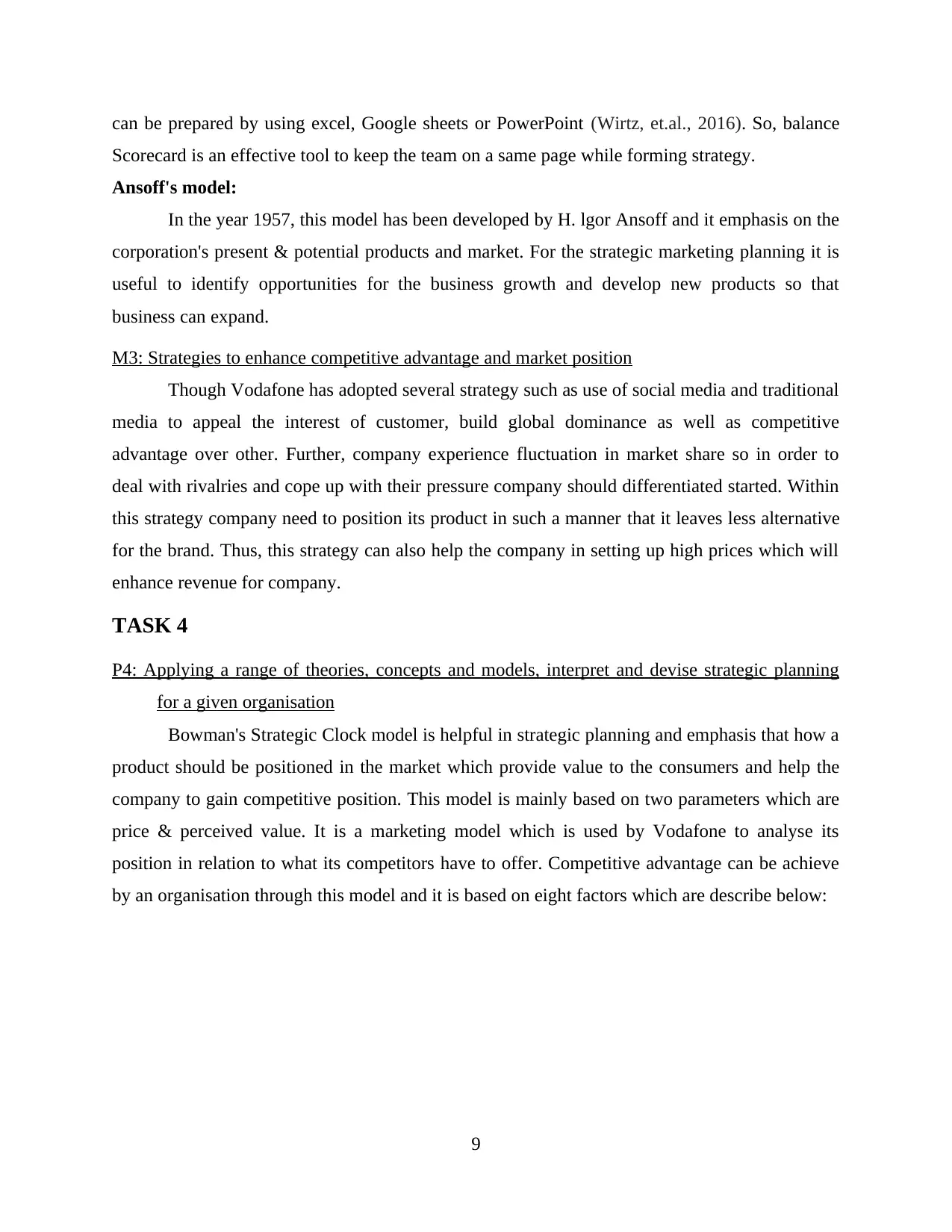
can be prepared by using excel, Google sheets or PowerPoint (Wirtz, et.al., 2016). So, balance
Scorecard is an effective tool to keep the team on a same page while forming strategy.
Ansoff's model:
In the year 1957, this model has been developed by H. lgor Ansoff and it emphasis on the
corporation's present & potential products and market. For the strategic marketing planning it is
useful to identify opportunities for the business growth and develop new products so that
business can expand.
M3: Strategies to enhance competitive advantage and market position
Though Vodafone has adopted several strategy such as use of social media and traditional
media to appeal the interest of customer, build global dominance as well as competitive
advantage over other. Further, company experience fluctuation in market share so in order to
deal with rivalries and cope up with their pressure company should differentiated started. Within
this strategy company need to position its product in such a manner that it leaves less alternative
for the brand. Thus, this strategy can also help the company in setting up high prices which will
enhance revenue for company.
TASK 4
P4: Applying a range of theories, concepts and models, interpret and devise strategic planning
for a given organisation
Bowman's Strategic Clock model is helpful in strategic planning and emphasis that how a
product should be positioned in the market which provide value to the consumers and help the
company to gain competitive position. This model is mainly based on two parameters which are
price & perceived value. It is a marketing model which is used by Vodafone to analyse its
position in relation to what its competitors have to offer. Competitive advantage can be achieve
by an organisation through this model and it is based on eight factors which are describe below:
9
Scorecard is an effective tool to keep the team on a same page while forming strategy.
Ansoff's model:
In the year 1957, this model has been developed by H. lgor Ansoff and it emphasis on the
corporation's present & potential products and market. For the strategic marketing planning it is
useful to identify opportunities for the business growth and develop new products so that
business can expand.
M3: Strategies to enhance competitive advantage and market position
Though Vodafone has adopted several strategy such as use of social media and traditional
media to appeal the interest of customer, build global dominance as well as competitive
advantage over other. Further, company experience fluctuation in market share so in order to
deal with rivalries and cope up with their pressure company should differentiated started. Within
this strategy company need to position its product in such a manner that it leaves less alternative
for the brand. Thus, this strategy can also help the company in setting up high prices which will
enhance revenue for company.
TASK 4
P4: Applying a range of theories, concepts and models, interpret and devise strategic planning
for a given organisation
Bowman's Strategic Clock model is helpful in strategic planning and emphasis that how a
product should be positioned in the market which provide value to the consumers and help the
company to gain competitive position. This model is mainly based on two parameters which are
price & perceived value. It is a marketing model which is used by Vodafone to analyse its
position in relation to what its competitors have to offer. Competitive advantage can be achieve
by an organisation through this model and it is based on eight factors which are describe below:
9
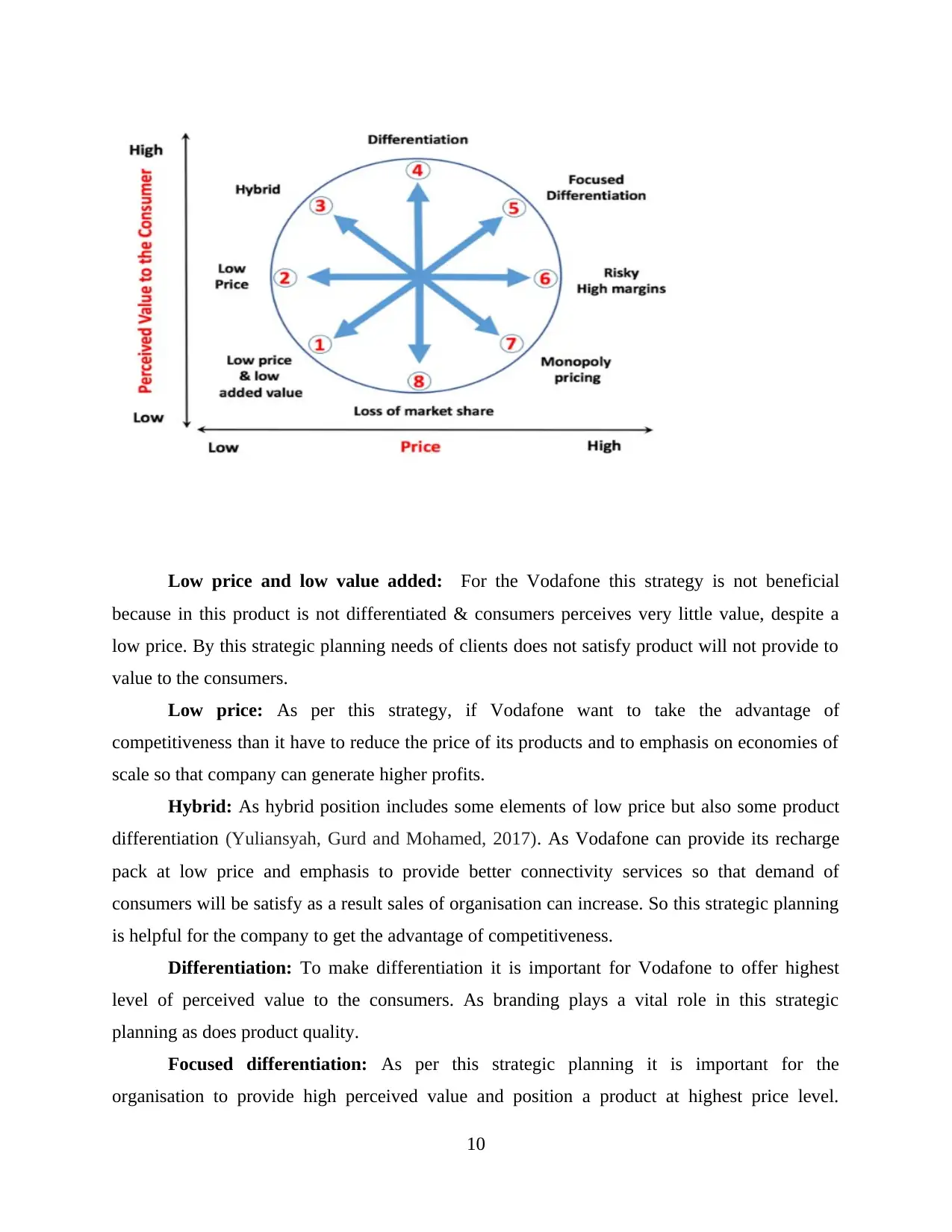
Low price and low value added: For the Vodafone this strategy is not beneficial
because in this product is not differentiated & consumers perceives very little value, despite a
low price. By this strategic planning needs of clients does not satisfy product will not provide to
value to the consumers.
Low price: As per this strategy, if Vodafone want to take the advantage of
competitiveness than it have to reduce the price of its products and to emphasis on economies of
scale so that company can generate higher profits.
Hybrid: As hybrid position includes some elements of low price but also some product
differentiation (Yuliansyah, Gurd and Mohamed, 2017). As Vodafone can provide its recharge
pack at low price and emphasis to provide better connectivity services so that demand of
consumers will be satisfy as a result sales of organisation can increase. So this strategic planning
is helpful for the company to get the advantage of competitiveness.
Differentiation: To make differentiation it is important for Vodafone to offer highest
level of perceived value to the consumers. As branding plays a vital role in this strategic
planning as does product quality.
Focused differentiation: As per this strategic planning it is important for the
organisation to provide high perceived value and position a product at highest price level.
10
because in this product is not differentiated & consumers perceives very little value, despite a
low price. By this strategic planning needs of clients does not satisfy product will not provide to
value to the consumers.
Low price: As per this strategy, if Vodafone want to take the advantage of
competitiveness than it have to reduce the price of its products and to emphasis on economies of
scale so that company can generate higher profits.
Hybrid: As hybrid position includes some elements of low price but also some product
differentiation (Yuliansyah, Gurd and Mohamed, 2017). As Vodafone can provide its recharge
pack at low price and emphasis to provide better connectivity services so that demand of
consumers will be satisfy as a result sales of organisation can increase. So this strategic planning
is helpful for the company to get the advantage of competitiveness.
Differentiation: To make differentiation it is important for Vodafone to offer highest
level of perceived value to the consumers. As branding plays a vital role in this strategic
planning as does product quality.
Focused differentiation: As per this strategic planning it is important for the
organisation to provide high perceived value and position a product at highest price level.
10
⊘ This is a preview!⊘
Do you want full access?
Subscribe today to unlock all pages.

Trusted by 1+ million students worldwide
1 out of 16
Related Documents
Your All-in-One AI-Powered Toolkit for Academic Success.
+13062052269
info@desklib.com
Available 24*7 on WhatsApp / Email
![[object Object]](/_next/static/media/star-bottom.7253800d.svg)
Unlock your academic potential
Copyright © 2020–2025 A2Z Services. All Rights Reserved. Developed and managed by ZUCOL.




